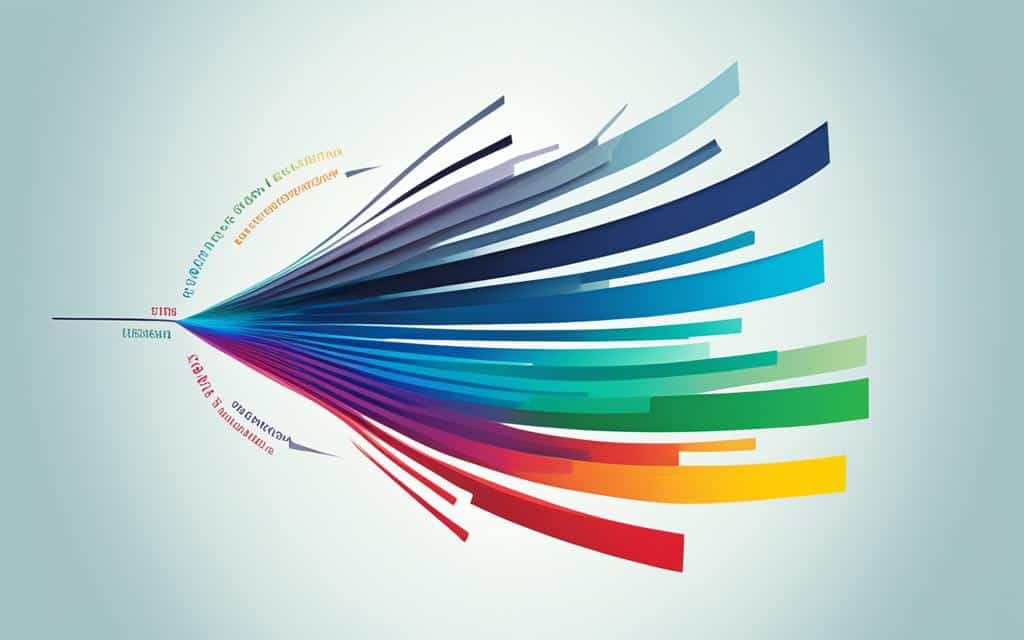Table of Contents
Color psychology is a powerful tool in branding that can influence consumers’ perceptions and purchasing decisions. Different colors evoke specific emotions and associations, which can shape brand perception. The study of color psychology in marketing and branding helps businesses choose the right colors that align with their brand identity and target audience.
What Is Color Psychology?
Color psychology delves into the study of how color impacts human behavior and emotions. Different colors, hues, and tones have the power to evoke specific associations and moods, ultimately influencing mood and decision-making processes. It’s important to note that color psychology can vary depending on personal preferences and cultural influences, highlighting the complexity of its effects on individuals. In the realm of marketing, color plays a significant role in shaping consumers’ perceptions of brands and products. Consequently, businesses must carefully select colors that align with their goals and target audience to create an impactful and persuasive brand image.
How Entrepreneurs Use Color Psychology
Color psychology plays a crucial role in how entrepreneurs shape consumer perception and decision making. The strategic use of colors can significantly impact consumers’ initial impressions, brand awareness, and purchasing decisions.
Studies have shown that colors can influence up to 90% of an initial impression formed about a product or brand. This highlights the importance of choosing the right colors to create a positive and memorable consumer experience.
Awareness and recognition are essential for building a strong brand presence. Colors can increase brand awareness by up to 80%, making them powerful tools for entrepreneurs to establish their brand identity in the market.
Visual elements play a significant role in consumer behavior, with many purchasing decisions being based on visuals alone. By understanding the principles of color psychology, entrepreneurs can leverage specific colors to evoke desired emotions and associations, ultimately influencing consumers’ perception and decision making.
Using color psychology strategically allows entrepreneurs to differentiate themselves from competitors. By selecting colors that align with their brand identity, entrepreneurs can create a distinctive and memorable brand presence that resonates with their target audience.
Entrepreneurs can also utilize color psychology to reinforce their brand messaging, values, and personality. By choosing colors that align with their desired brand associations, they can establish a deeper connection with their target audience and enhance brand loyalty.
Overall, color psychology is an essential element in branding and marketing strategies. Entrepreneurs who understand and apply the principles of color psychology can maximize the impact of their visual identity, effectively influencing consumer perception, brand awareness, and purchasing decisions.
| Color | Associations |
|---|---|
| Blue | Security, Wisdom, Trust |
| Red | Excitement, Energy, Passion |
| Green | Relaxation, Health, Prosperity |
| Purple | Royalty, Superiority |
| Yellow | Youthfulness, Happiness |
| Orange | Confidence, Creativity, Courage |
| Black | Sophistication, Elegance |
| White | Simplicity, Innocence |
| Pink | Femininity, Youthfulness |
Color Breakdowns
Each color has its own influence on consumers. Understanding the psychology behind each color can help entrepreneurs make informed decisions when selecting colors for their brand message and target audience.
Blue: Security, Wisdom, and Trust
Blue is widely regarded as the world’s favorite color, representing security, wisdom, and trust. It creates a sense of calmness and is often associated with reliability and professionalism. Many financial and technology brands use blue in their logos and branding to instill a feeling of trustworthiness in their customers.
Red: Excitement, Energy, and Passion
Red is a powerful color that evokes excitement, energy, and passion. It grabs attention and stimulates the senses. Many fast food chains and entertainment brands incorporate red in their branding to create a sense of urgency and excitement. Red can also provoke strong emotions, such as anger or love, depending on the context.
Green: Relaxation, Health, and Prosperity
Green symbolizes relaxation, health, and prosperity. It is associated with nature and the environment, representing freshness and growth. Green is often used by brands that promote sustainability, organic products, and well-being. It has a soothing effect on consumers and can instill a sense of calmness and harmony.
Purple: Royalty and Superiority
Purple is a color that represents royalty and superiority. It has long been associated with luxury and wealth. Brands that use purple in their branding often aim to create a sense of prestige and exclusivity. Purple can also evoke a sense of creativity and imagination, making it a popular choice for artistic and innovative brands.
Yellow: Youthfulness and Happiness
Yellow is a vibrant color that evokes youthfulness and happiness. It exudes positivity and optimism, making it an excellent choice for brands that want to create a cheerful and energetic image. Yellow is often used in industries related to entertainment, children’s products, and leisure.
Orange: Confidence, Creativity, and Courage
Orange is a color that conveys confidence, creativity, and courage. It combines the energy of red and the happiness of yellow. Brands that incorporate orange in their branding often want to appear friendly, approachable, and innovative. Orange can stimulate enthusiasm and evoke a sense of adventure.
Black: Sophistication and Elegance
Black symbolizes sophistication and elegance. It is often associated with luxury, power, and exclusivity. Brands that use black in their branding aim to create a sense of prestige and timelessness. Black can also evoke a feeling of mystery and intrigue.
White: Simplicity and Innocence
White represents simplicity and innocence. It is a clean and pure color that evokes a sense of clarity and honesty. Brands that use white in their branding often want to convey simplicity, purity, and minimalism. It provides a blank canvas for other colors and elements to stand out.
Pink: Femininity and Youthfulness
Pink appeals to femininity and youthfulness. It is often associated with charm, sweetness, and playfulness. Brands that target a predominantly female audience often use pink in their branding to create a feminine and romantic image. Pink can evoke feelings of tenderness and create a sense of nurturing.
Understanding the psychology behind each color is vital for entrepreneurs when choosing the right colors for their brand message and target audience. By selecting colors that align with their brand identity, entrepreneurs can effectively communicate their desired emotions and associations to consumers.
The Psychology of 12 Popular Colors
The psychology of color in branding and marketing is a fascinating area of study that explores how different colors can impact brand perception and consumer behavior. While colors may have general associations, it’s crucial to understand that individual experiences and cultural influences can shape these perceptions. When selecting colors for branding, considering the context and target audience is essential to create the desired impact. Let’s delve into the psychology of the 12 most popular colors:
1. Red
Red is a vibrant and attention-grabbing color that evokes strong emotions. It is associated with power, passion, and energy, but it can also convey anger and aggression. Brands that use red in their logos or packaging often aim to create a sense of excitement and urgency.
2. Orange
Orange is an energetic and enthusiastic color that can evoke feelings of warmth, creativity, and courage. It is often associated with enthusiasm and a sense of adventure. However, it can also be perceived as immature or less serious depending on the context and target audience.
3. Yellow
Yellow is a cheerful and optimistic color that symbolizes happiness and creativity. It can evoke feelings of warmth and joy. However, excessive use of yellow or in certain contexts, it might be associated with irrationality or caution (e.g., yellow caution signs).
4. Green
Green is a color associated with nature, relaxation, and prosperity. It can create a sense of calm and serenity, making it a popular choice for eco-friendly or health-focused brands. However, in some cases, green can be perceived as monotonous or associated with boredom.
5. Purple
Purple is often associated with luxury, royalty, and creativity. It exudes a sense of sophistication and wealth. However, excessive use of purple or in specific contexts, it can be associated with decadence or arrogance.
6. Blue
Blue is one of the most popular colors and is often associated with trust, security, and reliability. It instills a sense of calmness and serenity. On the other hand, an excessive use of blue can create a cold and emotionless perception.
7. Grey
Grey is a neutral color that is often associated with practicality and sophistication. It can create a sense of balance and professionalism. However, an excessive use of grey can be perceived as dull or unexciting.
8. Brown
Brown is a warm and earthy color that is often associated with reliability and stability. It can evoke feelings of warmth and comfort. However, depending on the context, brown can also be perceived as plain or unexciting.
9. Black
Black is a color of sophistication, elegance, and power. It is often associated with luxury and high-end products. Using black in branding can create a sense of exclusivity and timelessness. However, an excessive use of black can give a negative impression of darkness or sadness.
10. White
White is a color associated with purity, simplicity, and innocence. It can create a sense of cleanliness and freshness. White is often used in healthcare, beauty, and technology industries. However, an excessive use of white can be perceived as cold or sterile.
11. Pink
Pink is often associated with femininity, romance, and youthfulness. It can evoke feelings of sweetness and tenderness. Pink is commonly used in industries such as fashion, beauty, and confectionery. However, in some contexts, pink can be perceived as too feminine or lacking seriousness.
12. Beige
Beige is a soft and calming color that is often associated with simplicity and elegance. It can evoke feelings of relaxation and comfort. Beige is commonly used in interior design, fashion, and cosmetics. However, an excessive use of beige can create a mundane or uninspiring perception.
Understanding the psychology of these 12 popular colors empowers entrepreneurs to choose the right colors that align with their brand personality and evoke the desired emotions and associations in their target audience. Color psychology is a powerful tool in branding and marketing, enabling businesses to create memorable brand experiences and influence consumer behavior.
Conclusion
The science of color psychology plays a pivotal role in the world of branding, demonstrating the significant influence that colors can have on consumer perception. By delving into the psychology of color, entrepreneurs can make strategic decisions that align their brand identity with the target audience, as well as evoke desired emotions and associations.
It is crucial to recognize that the right choice of colors can create a memorable brand experience and boost brand recognition. Leveraging color psychology principles, entrepreneurs can shape consumer perception, ultimately influencing purchasing decisions in their favor.
By understanding how different colors evoke specific emotions and associations, entrepreneurs can create impactful and effective branding strategies. These strategies utilize the psychological power of colors to convey brand messaging, connect with the audience on a deeper level, and drive consumer engagement.
FAQ
What is color psychology?
Color psychology is the research of how color affects human behavior and emotions. Different colors, hues, and tones evoke specific associations and moods, which can impact mood and decision making.
How do entrepreneurs use color psychology?
Entrepreneurs use color psychology to shape consumer perception and decision making. Colors can influence up to 90% of an initial impression and increase brand awareness and recognition by 80%. Entrepreneurs can use color psychology to target specific emotions and associations that align with their brand identity and differentiate themselves from competitors.
What influences color psychology in branding?
The psychology of color in branding is influenced by personal experiences and cultural factors. While certain colors may have general associations, it’s important to consider the context and audience when selecting colors for branding.
What are the associations with different colors?
Each color has its own influence on consumers. Blue is associated with security, wisdom, and trust. Red is associated with excitement, energy, and passion. Green represents relaxation, health, and prosperity. Purple symbolizes royalty and superiority. Yellow evokes youthfulness and happiness. Orange conveys confidence, creativity, and courage. Black signifies sophistication and elegance. White represents simplicity and innocence. Pink appeals to femininity and youthfulness.
How can entrepreneurs choose the right colors for branding?
By understanding the psychology of each color, entrepreneurs can select colors that align with their brand message and target audience. This allows them to evoke the desired emotions and associations in their target audience and create impactful and effective branding strategies.
What is the impact of color psychology in branding?
The science of color psychology in branding highlights the powerful influence colors have on consumer perception. By strategically selecting colors that align with their brand identity, target audience, and desired emotions and associations, entrepreneurs can increase brand recognition, create a memorable brand experience, and ultimately influence purchasing decisions.







